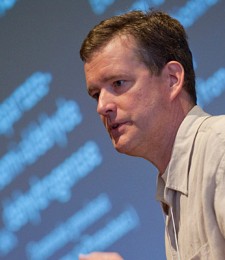Deputy Dean and Assoc. Dean for Research & Graduate Education
Professor of Environmental Microbiology
University of Delaware
Delaware Biotechnology Institute
590 Avenue 1743
Newark, DE 19713
Email: wommack@udel.edu
Phone: (302) 831-4362
Fax: (302) 831-3409
SciNav Link: http://scinav.udel.edu/individual.php?lastname=%27Wommack%27&firstname=%27K.%20Eric%27
Ph.D., Marine Estuarine Environmental Sciences, University of Maryland, 1998
M.Sc., Physiology, University of St. Andrews, Scotland, 1990
B.S. (hons) Biology, Emory University, 1987
B.A. Economics, Emory University, 1987

In the past two decades we have learned that viruses are the most abundant biological entities on Earth. The vast abundance of viruses within natural ecosystems is paralleled by their extraordinary diversity. It is likely that dsDNA viruses also comprise Earth’s largest pool of unknown and novel genetic diversity. Understanding the influence and importance of viral processes within natural ecosystems is the central research focus of my laboratory. The encompassing nature of ecological research means that the work of my laboratory is highly varied and includes field measurements of microbiological processes; quantitative microscopy of viruses within field samples; molecular genetic analysis of viral assemblages; and assessment of viral diversity through high-throughput DNA sequence analysis (viral metagenomics). In particular, the computationally-intensive analyses associated with viral metagenomics also means that the work of the lab is highly interdisciplinary requiring close interaction of computer scientists and environmental microbiologists. My on going viral ecology research programs span the biosphere and include investigations of agricultural soils, coastal marine environments, deep-sea hydrothermal vents, poultry production houses, and the microbial communities associated with the human body. Throughout our studies in these disparate environments my lab seeks to define the abundance, diversity, and activity of indigenous viral assemblages with a particular focus on uncovering those genetic elements essential to key viral functions within a given microbial community.